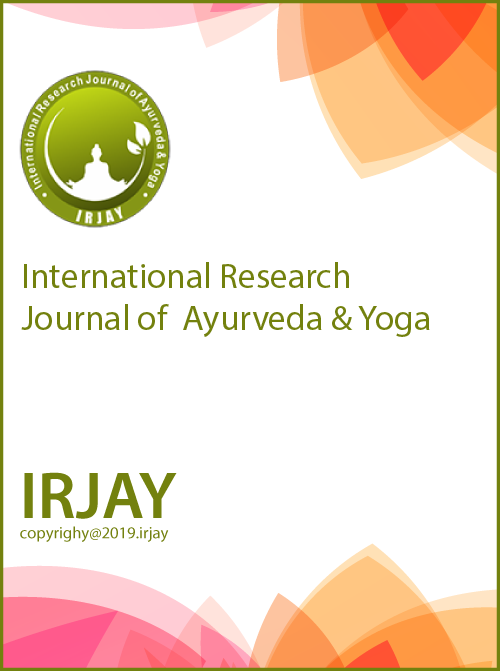Comparative Effects of Unilateral and Bilateral Nostril Breathing on Autonomic Function in Yoga Practitioners and Healthy Male Controls
Keywords:
Autonomic function, Cardiovascular, Heart rate variability, Heart rate variability, Non-pharmacological, Parasympathetic, Pranayama, Sympathetic, Yoga, nostril breathingAbstract
Background: The autonomic nervous system (ANS) plays a central role in regulating physiological homeostasis, particularly cardiovascular and respiratory responses. Yogic breathing practices, including unilateral nostril breathing (UNB) and bilateral nostril breathing (BNB), have been reported to influence ANS balance. However, differential autonomic responses to these practices in Yoga-trained versus untrained individuals remain insufficiently understood. Aim: This study aims to compare the effects of UNB and BNB techniques on autonomic function, measured through standard cardiovascular autonomic tests, in Yoga practitioners and healthy male controls. Materials and Methods: Seventy-five healthy male participants (age 18–31) were divided into three groups (n = 25 each): Group 1 (UNB practitioners), Group 2 (BNB practitioners), and a control group with no Yoga training. Yoga groups underwent an 8-week intervention consisting of Chandra Nadi (left), Surya Nadi (right), Nadi Shuddhi, Ujjayi, and Bhramari Pranayama. Participants were tested pre- and post-intervention using the following autonomic function tests: Resting heart rate (RHR), deep breathing test (DBT), orthostatic test, and sustained hand grip test (SHGT). Heart rate variability (HRV) was assessed via time- and frequency-domain indices, including low-frequency (LF), high-frequency (HF), and LF/HF ratio. Intervention: Yoga groups practiced breathing techniques 5 days a week for 8 weeks under guided instruction. Each session lasted 30–40 min. The control group received no intervention but was subjected to the same assessment schedule. All tests were conducted under fasting and standardized conditions. Results: Significant differences were observed post-intervention between Yoga groups and the control group. Yoga Group 2 (BNB) showed the most pronounced improvement across all parameters. RHR decreased significantly in Yoga groups compared to controls (Group 2: 69.53 ± 4.46 bpm; Control: 79.51 ± 4.74 bpm, P < 0.05). DBT variability increased (Group 2: 19.31 ± 4.19 bpm vs. Control: 12.62 ± 4.31 bpm, P < 0.05), indicating enhanced vagal tone. The Orthostatic Test showed reduced systolic BP response in Yoga groups (Group 2: 7.40 ± 5.16 mm Hg vs. Control: 9.98 ± 5.99 mm Hg), suggesting better baroreceptor sensitivity. SHGT revealed higher systolic reactivity in Yoga groups (Group 2: 18.91 ± 5.13 mm Hg vs. Control: 12.97 ± 5.20 mm Hg), potentially indicating improved sympathetic efficiency under load. HRV analysis showed a shift toward parasympathetic dominance in both Yoga groups, particularly in BNB. Conclusion: Both UNB and BNB practices significantly improve autonomic function, with bilateral breathing exhibiting superior effects. Regular pranayama enhances parasympathetic tone, modulates sympathetic reactivity, and fosters cardiovascular resilience. Yoga practitioners demonstrated greater autonomic adaptability than non practitioners, underscoring the potential of breath-based Yogic interventions as non-pharmacological strategies for improving autonomic health.
Downloads
References
1. Shaffer F, Ginsberg JP. An overview of heart rate variability metrics and norms. Front Public Health. 2017;5:258. doi: 10.3389/ fpubh.2017.00258
2. Saoji AA, Raghavendra BR, Manjunath NK. Effects of yogic breath regulation: A narrative review of scientific evidence. J Ayurveda Integr Med. 2019;10(1):50-8. doi: 10.1016/j.jaim.2017.07.008
3. Telles S, Joseph C, Venkatesh S, Nagarathna R. Changes in autonomic nervous system associated with yoga training. Indian J Physiol Pharmacol. 1996;40(3):262-8.
4. Telles S, Sharma SK, Yadav A, Singh N, Balkrishna A, Gupta RK. Heart rate variability in practitioners of sudarshan kriya yoga. J Clin Diagn Res. 2017;11(4):CC01-3.
5. Shannahoff-Khalsa DS. Psychophysiological states: The ultradian dynamics of mind-body interactions. Int J Neurosci. 2007;117(2):179-219.
6. Chennaoui M, Arnal PJ, Sauvet F, Léger D. Sleep and exercise: A reciprocal issue? Sleep Med Rev. 2015;20:59-72. doi: 10.1016/j. smrv.2014.06.008
7. Khattab K, Khattab AA, Ortak J, Richardt G, Bonnemeier H. Iyengar yoga increases cardiac parasympathetic nervous modulation among healthy Yoga practitioners. Evid Based Complement Alternat Med. 2007;4(4):511-7. doi: 10.1093/ecam/nem087
8. Sengupta P. Health impacts of Yoga and pranayama: A state-of-the art review. Int J Prev Med. 2012;3(7):444-58.
9. Shannahoff-Khalsa DS. Unilateral forced nostril breathing: Basic science, clinical trials, and selected advanced techniques. Subtle Energies Energy Med J. 2004;15(1):5-24.
10. Pal GK, Velkumary S, Madanmohan. Effect of short-term practice of breathing exercises on autonomic functions in normal human volunteers. Indian J Med Res. 2004;120(2):115-21.
11. Udupa KN, Singh RH, Settiwar RM. A comparative study on the effect of some individual yogic practices in normal persons. Indian J Med Res. 1975;63(8):1066-71.
12. Telles S, Reddy SK, Nagendra HR. Oxygen consumption and respiration following two yoga relaxation techniques. Appl Psychophysiol Biofeedback. 2000;25(4):221-7.
13. Harinath K, Malhotra AS, Pal K, Prasad R, Kumar R, Kain TC, Rai L, Sawhney RC. Effects of hatha yoga and omkar meditation on
cardiorespiratory performance, psychologic profile, and melatonin secretion. J Altern Complement Med. 2004;10(2):261-8. 14. Joshi K. Effect of yoga on cardiac parameters. Indian J Physiol Pharmacol. 1992;36(4):265-8.
15. Gharote ML. Effect of yoga on the parasympathetic nervous system. J Yoga Res Practice. 1993;3(1):15-9.
16. Bagchi BK, Wenger MA. Electrophysiological correlates of some yogi exercises. Electroencephalogr Clin Neurophysiol. 1957;7(2):132-49. 17. Pramanik T, Sharma HO, Mishra S, Mishra A, Prajapati R, Singh S. Immediate effect of slow pace bhastrika pranayama on blood pressure and heart rate. J Altern Complement Med. 2009;15(3):293-5. 18. Tulpule TH, Shah SA, Kamath SG. Yoga and cardiovascular health. J Postgrad Med. 1998;44(1):4-6.
19. Vijaya Lakshmi P, Nayar U, Krishnamurthy K. Influence of yoga on blood pressure, heart rate, and cardiac autonomic functions in hypertensive patients. J Indian Med Assoc. 2004;102(2):96-9.


